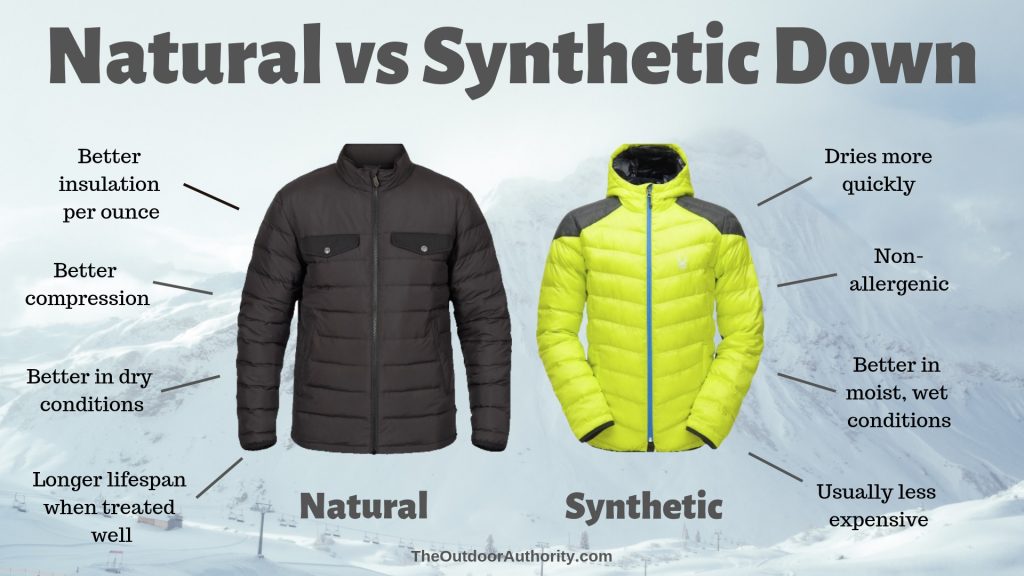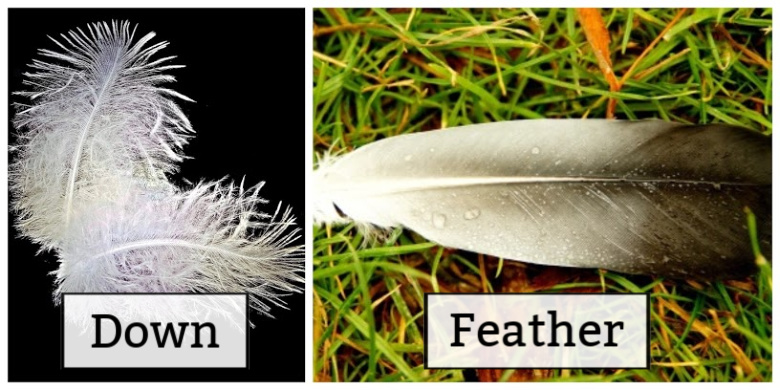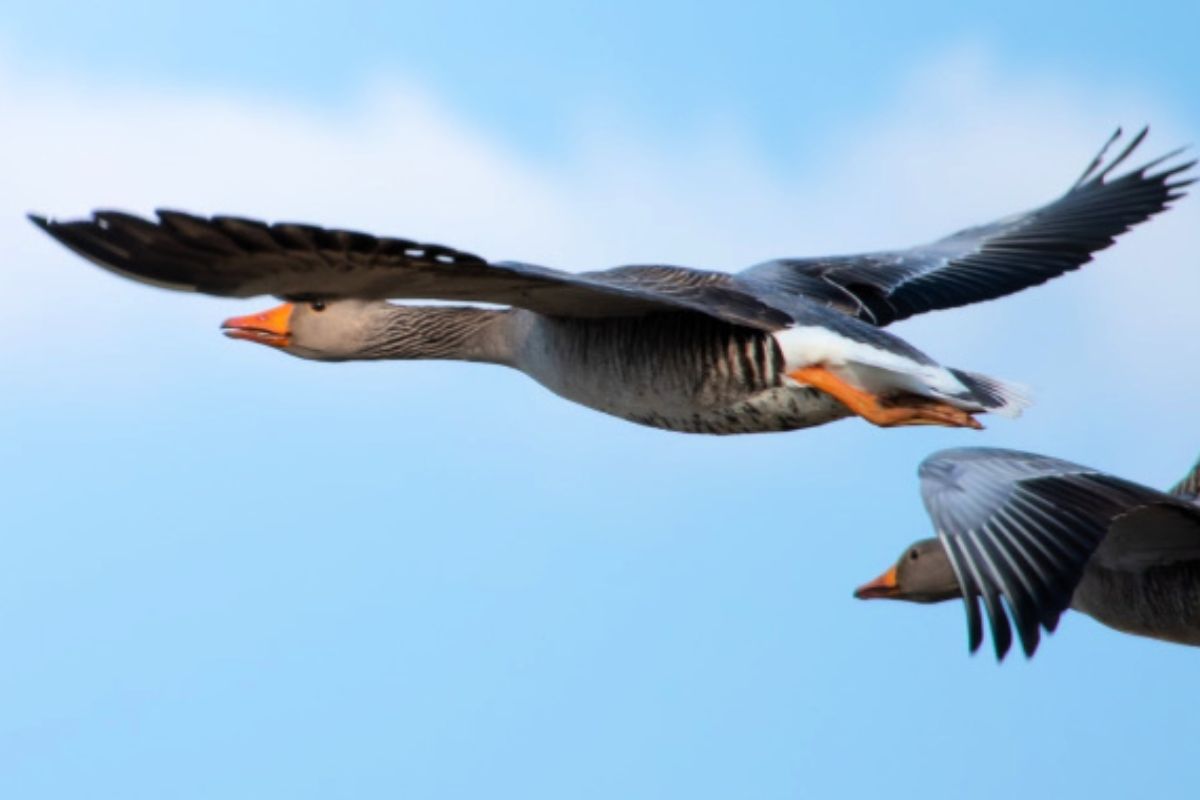Let me guess. You’re doing some shopping and you keep seeing “100% goose down” or “PrimaLoft Gold.”
You probably want to know what those are and whether you should be buying one or the other.
You’re in the right place!
Down vs synthetic is one of the most important decisions you’ll make for your outdoor gear. That’s because you, the savvy shopper, want to:
- Choose the right product to keep you warm;
- That will last a long time;
- Without paying through the nose.
Well, let’s get down and dirty with down vs synthetic insulation.
Table Of Contents
Down vs Synthetic at the 30,000 Foot Level
I used to be in the corporate world, and my boss loved at say things like “at 30,000 feet, our strategy is [insert something ludicrous here].”
Essentially it’s the high-level picture without mentioning many details.
Because there are so many types of both natural down and synthetic fibers, the exact differences between them will vary. Ninety percent goose down with 800-fill power vs PrimaLoft synthetic filling? We can get specific about that. But down vs synthetic as a whole requires a lot more generality.
So here’s your 30,000 foot comparison of down vs synthetic insulation:

Advantages of Down Insulation
- Better insulation-to-weight ratio
- Better compression
- Better in dry conditions
- Longer lifespan when treated well
Advantages of Synthetic Insulation
- Dries more quickly
- Non-allergenic
- Better in moist, wet conditions
- Usually less expensive
Down Insulation: A Deep Dive
There’s a lot to talk about here, so let’s start with the obvious question:
What is down?
Down is the insulating under-layer of a bird’s coat. Down resembles feathers, but they’re actually different.

Down is what keeps birds warm. It’s light and fluffy and has thousands of tiny air pockets between the fibers. These air pockets are what give it superior powers of insulation.
Feathers are compact and lack the same air pockets of down, which means they also lack the same powers of insulation.
Frequently you’ll see down products advertised as 90% down and 10% feathers (or some other blend). Blends with some percentage of feathers usually are less expensive because manufacturers weren’t as careful to separate the down from the feathers.
This means those products won’t have the same insulation and compression of other products with the same fill power but 100% down, but the price can be more appealing.
What are the different types of down?
Generally you’ll come across two types of down:
- Goose down
- Duck down
Goose down has more loft, which means more tiny air pockets and better insulation.
But not all goose or duck down is the same, so not all duck down is worse than all goose down. To dial in the insulating power of the down in question, you need to look at its fill power.
What is fill power?
Fill power is the most important thing to know when assessing insulation power (but it isn’t the only thing to know).
Let’s let the fine folks at REI tell us!
Fill power is a number that indicates the relative quality of down. The number comes from a lab test that measures how many cubic inches of loft one ounce of that down fill produces. Higher fill power numbers indicate greater loft and insulating efficiency.
Ken Knapp, REI
Fill power is expressed as a number, such as 800 or 600, where higher equals more loft, better insulation, and better compression.
Note: An 800-fill power product isn’t guaranteed to be warmer than a 600-fill power product. Fill weight (how much down is being used), seam construction, fit, zippers, and other factors all have an impact. But in general, a higher fill power means more warmth.
Why doesn’t down insulate well when wet?
Insulating power comes from the number of tiny air pockets in a particular material. Down has a ton of tiny air pockets when dry. But when the down gets wet, it clumps together and those air pockets vanish.
To combat this obvious weakness, manufacturers have developed Durable Water Repellent (DWR) down. REI has a great description of what DWR down is. Essentially, the down is coated in a synthetic substance that repels the water and prevents it from clumping up. This is also referred to as hydrophobic down.
You’ll also find products that have a DWR exterior to seal out moisture so the down can still insulate even if the down itself isn’t hydrophobic.
Synthetic Insulation: A Deep Dive
As the name implies, synthetic insulation isn’t natural. So, what is it then?
What is synthetic insulation?
“Synthetic insulation” is the general term for any kind of man-made material used in place of natural down. Many companies have their own proprietary types of synthetic insulation that they either use in their own products or sell to gear manufacturers.
Here’s a shortlist of the various types of synthetic insulation:
The links above will give you more details about each. The general goal of each manufacturer is to create the closest thing to natural down — great insulation with little weight — while being affordable and water-resistant.
Is synthetic insulation as good as down?
That depends on what you mean by good. In terms of insulation-to-weight ratio, no. There is no synthetic insulation that matches natural goose or
In terms of cost? Yes, synthetic insulation is cheaper than natural down.
In terms of performance? Maybe. While the insulation-to-weight ratio of synthetic materials doesn’t stand up to down, it is water-resistant and non-allergenic.
To better illustrate the differences between down and synthetic insulation, let’s compare one of the top synthetics: PrimaLoft vs down.
PrimaLoft vs down
PrimaLoft is a synthetic insulation made by PrimaLoft, Inc. The North Face, Patagonia, and Under Armour are among the many companies to use PrimaLoft insulation to create synthetic down products.
PrimaLoft is made with 100% polyester microfiber and comes in three types: Gold, Silver, and Black. Here’s a quick breakdown of each:
- Gold: Comparable to 550-fill power down
- Silver: Comparable to 450-fill power down
- Black: Comparable to 350-fill power down
Of course, there’s more to warmth than just fill power — fill weight (amount of insulation), construction, thickness, etc. — but clearly none of these top-of-the-line PrimaLoft synthetics can match down ounce-for-ounce.
However, PrimaLoft and other synthetics have the benefits of being completely water-resistant, non-allergenic, and less expensive.
Why/when would someone choose synthetic insulation?
If you truly want the best performance and don’t care the cost, you want 800+ fill power down with a hydrophobic, DWR coating. It doesn’t get any better than that. You’ll be able to trek into the coldest conditions — even
But not everyone is looking to buy a $1,000+ down jacket or sleeping bag. Sometimes we don’t need to be exposed to sub-zero conditions. Here are some times you may be better served going with synthetics:
- Cost is a concern
- Camping in very wet conditions
- Non-sub-zero conditions
- Or possibly sub-zero if you can stand the added weight/bulk
- Daily wearers for cold morning commutes
- Car camping, where you drive in and out and don’t need to worry about weight and compressibility
For backpackers, section hikers, and thru-hikers who need to travel minimalist, you’re better served spending up for high-quality down products, because weight and compressibility have added importance.
Note: You’ll also come across products that are down/synthetic blends, such as 70% goose down and 30% synthetic
You’ll run into this down vs down alternative discussion with various types of survival products, but I want to call out two in particular that get most of the attention:
- Down vs synthetic sleeping bags
- Down vs synthetic jackets
Let’s take a quick look at each.
Down vs Synthetic Sleeping Bags
For multi-day backpacking trips, your sleeping bag can be a literal life saver. If you’re venturing into potentially cold conditions, give down a strong look unless you think there’s a risk of excessive rain and moisture.
The major benefit of down, again, is it’s superior weight and compressibility, which are ideal for minimalist excursions. If you’ll be in warmer weather and don’t need the insulation, synthetic sleeping bags can be a great, affordable option since you won’t need them to be as thick.
We have a full Down vs Synthetic Sleeping Bag comparison designed to help you choose the right sleeping bag for your needs. We also have a guide to the 7 Best Cold Weather Sleeping Bags for Sub-Zero Survival.
Down vs Synthetic Jackets
Unless I’m going to be in cold conditions with potential for heavy rain (hello, Pacific Northwest in the fall!) I always prefer down. I hate feeling like a bloated puff ball when I’m walking around, and that’s more of the feeling you get with synthetic jackets.
But as always, your mileage may vary.
We’ve put together a guide to the 14 Best Down Jackets, which I think is a great place to get started if you’re shopping for a new jacket. We highlight the best jackets to keep you warm in everything from Antarctic cold to a brisk fall morning.
Do you have a thought or experience to share in this down vs synthetic discussion? Perhaps a favorite product or a time when either down or synthetic insulation came in handy? Let us know on social media!

